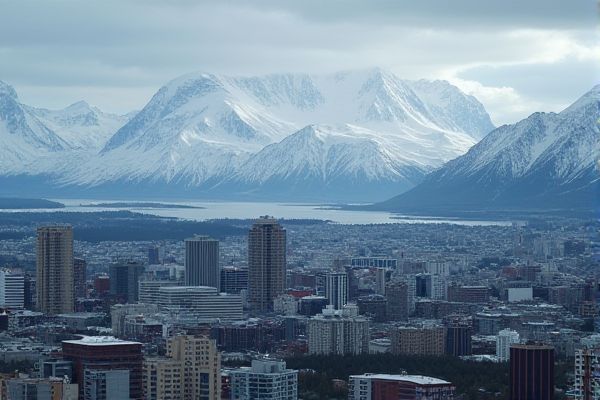
Transportation and commuting in Alaska: Limited road network connectivity. Expensive fuel costs. Seasonal road accessibility. Bush planes for remote areas. Alaska Marine Highway System ferries. Limited public transportation options. Anchorage has public transit. Snow tires required in winter. Cycling during summer months. Carpooling to reduce costs.
Limited road network connectivity.
Alaska's road network is highly limited, featuring only 15,718 miles of public roads, many of which remain unpaved. Notably, the state capital, Juneau, is not accessible by road, reflecting the unique challenges faced within this vast region. The current road system connects several major Southcentral population centers with Fairbanks and the Canadian border, yet it leaves much of the state inaccessible by highway vehicle, thereby relying heavily on air and marine transportation. For more comprehensive insights into the transportation framework of this unique state, visit the Transportation in Alaska page on Wikipedia.
Expensive fuel costs.
Alaska's transportation and commuting are significantly impacted by expensive fuel costs, as the state has the highest energy demand per capita in the nation. Diesel fuel, in particular, is crucial for heating, transportation, electric power, and other uses, with the state relying heavily on diesel-fueled generators in rural areas and experiencing high per capita petroleum consumption. For more detailed analysis, visit the EIA website to understand Alaska's unique energy landscape.
Seasonal road accessibility.
In Alaska, seasonal roads are built on the tundra and rivers, providing critical access to communities and facilities without permanent road connections. Especially during winter, these roads are constructed using compacted snow and naturally frozen water surfaces to facilitate the transport of heavy equipment and essential supplies. For more adventures and information on these fascinating pathways, visit High Latitude Style to explore how these seasonal routes contribute to survival and exploration in the Alaskan landscape.
Bush planes for remote areas.
In Alaska, bush planes are essential for transporting people, supplies, and conducting rescue operations in remote areas where infrastructure is limited. These aircraft are specifically designed with features like rugged construction, short takeoff and landing capabilities, and specialized landing gear to adeptly navigate rough terrain and unprepared surfaces. For more information, explore the Fly Around Alaska Flight School, where aspiring pilots can learn the intricacies of managing these vital aircraft in challenging environments.
Alaska Marine Highway System ferries.
The Alaska Marine Highway System (AMHS) is a ferry service that operates along the south-central coast of Alaska, the eastern Aleutian Islands, and the Inside Passage, connecting 32 terminals in Alaska, British Columbia, and Washington. The ferries transport people, freight, and vehicles, serving communities with no road access, and offer various routes, including cross-gulf sailings, though some routes are temporarily unavailable due to vessel upgrades. To explore more about the available routes and schedule updates, visit the Alaska Marine Highway System website.
Limited public transportation options.
Alaska faces significant challenges in public transportation due to its vast and remote geography, with many communities relying on air travel and ferries, and limited road connectivity. Particularly in areas like Juneau, which has no road connections to the rest of Alaska or North America, these hurdles are pronounced. The state's transportation infrastructure underscores the importance of innovative solutions and strategic planning to overcome such barriers. For more in-depth analysis, the Alaska Moves 2050 Transportation Assessment provides a comprehensive overview of these issues and potential future developments in the sector.
Anchorage has public transit.
Anchorage's public transportation, known as People Mover, offers reliable, modern, and accessible bus services with frequent routes, including connections to the airport, downtown, and various popular locations. The service operates from 6 a.m. to midnight on weekdays and 8 a.m. to 8 p.m. on weekends, ensuring convenience for both locals and visitors.
Snow tires required in winter.
In Alaska, the use of studded tires has been extended until May 15, 2024, for areas north of the 60-degree North Latitude line, owing to the prolonged winter weather. This extension is crucial for ensuring road safety in regions that experience harsh and extended winter conditions. Meanwhile, areas situated below this latitude must adhere to the April 15, 2024, deadline, allowing the efficient transition to regular tires as the weather permits. To learn more about this regulation, visit the detailed update available on KVAK Radio, which covers the implications of this timing and other related local news.
Cycling during summer months.
Cycling in Alaska during the summer months offers a unique experience with rugged beauty, though the riding season is limited to about four months in some areas. The state has well-developed bike infrastructure, including bike lanes, separated paths, and Guided Tours, making it an attractive destination for cyclists despite the varied and sometimes challenging weather conditions.
Carpooling to reduce costs.
In Anchorage, Alaska, the RideShare vanpooling program, managed by Commute with Enterprise, offers commuters the opportunity to share a ride, thus significantly reducing costs, traffic congestion, and carbon emissions. This innovative program accommodates groups of five or more riders, providing a low monthly rate, covering fuel costs, and offering 24/7 assistance. By participating in the RideShare Program, individuals can take advantage of these benefits while contributing to a more sustainable and efficient transportation system in the region.
